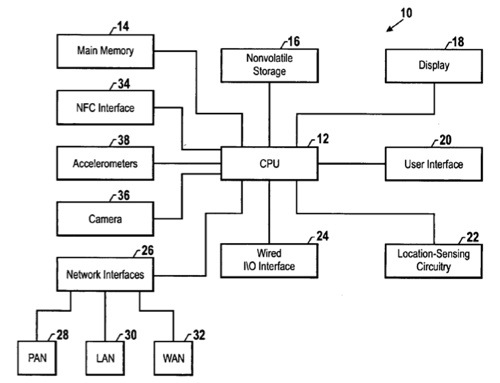Future iPhones, iPod touches and iPads could serve up advertisements or discount coupons to users based on their current location or activity, per a new Apple patent (number 20100125492) at the US Patent & Trademark Office.
The patent is for a system and method for providing contextual advertisements according to a dynamic pricing scheme. Systems, methods, and devices for providing electronic advertisements according to a dynamic pricing scheme are provided. For example, a method for providing an electronic advertisement according to a dynamic pricing scheme may include transmitting an advertisement to an electronic device belonging to a user and receiving marketing factors indicating a likelihood that the user will be receptive to the advertisement.
The advertisement may be configured for display on the electronic device and at least one of the marketing factors may be received from the electronic device. A price for providing the advertisement to the target user may be determined based on the marketing factors. The inventors are Gloria Lin and Michael Rosenblatt.
Here’s Apple’s summary of the invention: “Certain aspects commensurate in scope with the disclosed embodiments are set forth below. It should be understood that these aspects are presented merely to provide the reader with a brief summary of certain forms the invention might take and that these aspects are not intended to limit the scope of the invention. Indeed, the invention may encompass a variety of aspects that may be set forth below.
By way of example, a method for providing an electronic advertisement according to a dynamic pricing scheme may include transmitting an advertisement to an electronic device belonging to a user and receiving marketing factors indicating a likelihood that the user will be receptive to the advertisement. The advertisement may be configured for display on the electronic device and at least one of the marketing factors may be received from the electronic device. A price for providing the advertisement to the target user may be determined based on the marketing factors.”
The patent almost certainly ties in with Apple’s iAd. At the unveiling of iPhone OS 4, Apple debuted iAd, Apple’s new mobile advertising platform, which “combines the emotion of TV ads with the interactivity of web ads,” Apple CEO Steve Jobs said.
Today, when users click on mobile ads they are almost always taken out of their app to a web browser, which loads the advertiser’s web page. Users must then navigate back to their app, and it’s often difficult or impossible to return to exactly where they left. Jobs said iAd solves this problem by displaying full-screen video and interactive ad content without ever leaving the app, and letting users return to their app anytime they choose.
He added that iPhone OS 4 lets developers embed iAd opportunities within their apps, and the ads are dynamically and wirelessly delivered to the device. Apple will sell and serve the ads, and developers will receive an industry standard 60% of iAd revenue.
However, Flash ads need not apply. They must be built with HTML. To put it mildly, Jobs is NOT a fan of Flash. iAds can be designed by app developers as well as advertising agencies.


